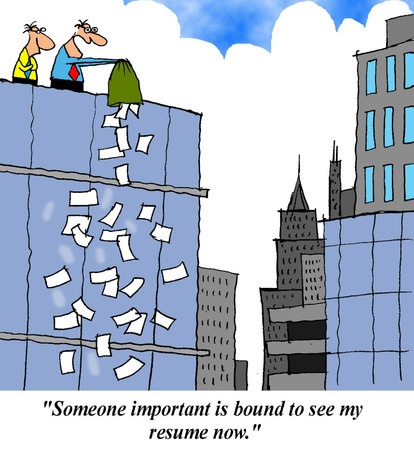How To Show Momentum On Your Executive Resume
Unfortunately, most resumes, including executive resumes, show change not momentum. Many of the resumes I see indicate that the client has moved from one position to another, but doesn’t emphasize the underlying factors.
One of the reasons employers prefer reverse-chronological resumes is because they show a candidate’s career progression. But, when you want to convey value it’s not enough to just indicate that you moved from one position to another. Even if that move has been to a higher position.
Some people are moved up the ladder because they’ve been with a company the requisite time. Others are promoted because of their achievements.
Consider that when putting together your executive resume.
Let’s say you were recruited by your current employer right out of college. Over the last 10 years you’ve changed positions 3 times. Maybe each time you were even promoted.
That’s great.
But, depending on your particular situation, it might be even better.
Do You Want To Know What Hiring Managers Think?
Looking for a job isn’t easy. Getting an interview is tough. Securing an offer is even tougher.
If the whole process was easy, unhappy workers wouldn’t hesitate to make a change. People wouldn’t be as devastated when they lost a job.
Of course, one of the most difficult thing for jobseekers is trying to figure out what hiring managers think. What are they looking for? What questions will they be asked during an interview? Is talking badly about a boss or former boss really that bad?
The list of questions goes on.
Well, today, we’re going to provide some insights gleaned from a survey of hiring managers conducted by Simply Hired**.
What You Can Expect
While a robust, optimized LinkedIn profile is essential to being found on LinkedIn, most (71%) of hiring managers don’t check candidate’s profiles. Of course, that means almost 30% do.
Does Your Executive Resume Generate Calls?
Early in your career a resume that proves you have experience may be enough to get you the job. Once you’ve reached the executive level, it’s not.
Once you’re at the executive level, or are targeting those roles, you need to demonstrate value.
The value you bring to a potential employer.
At this level, recruiters and employers won’t be impressed that you managed a team, even a large team. That’s expected.
Recruiters and hiring managers want to see the positive impact you’ve had on your current and previous employers. The impact you’ve had on your team, on your department, or across the company.
How To Get Recruiters To Actually Read Your Resume
You may think that a recruiter or hiring manager will read your resume from top to bottom as soon as they receive it. They won’t.
You may also think that every, single, thing you’ve done over the last 20 years is important. It’s not.
Most readers will quickly scan your resume looking for information relevant to the job they are trying to fill. A first read generally lasts only a few minutes. If your resume is 3-5 pages, they may not review the entire document.
In most cases, only if a recruiter or hiring manager likes what they’ve found on the initial scan will they read the entire resume.
While there are mixed opinions on how long a resume should be – no one’s resume needs to be seven or eight pages. Yes, when I was working as a recruiter I saw them. I still see them today.
3 Reasons Recruiters Aren’t Calling You
As a businessperson, I go to a lot of networking events. Some, like SHRM, provide professional development. Often, I’m speaking at job seeker groups. Wherever the event, I always meet people who are looking for a new job.
Their most common complaint is not getting interviews.
Before becoming a resume writer, I worked as a recruiter. That means I reviewed countless resumes and spent hours on LinkedIn looking for candidates. That experience gives me some insight into why recruiters call some candidates but not others. Here are 3 reasons.
Protect Your LinkedIn Profile Today
When Microsoft purchased LinkedIn, everyone knew there would be changes. The end of last year, LinkedIn rolled out a big one. It’s called Resume Assistant.
According to LinkedIn, Resume Assistant provides samples from successful professionals that can be used as inspiration for members who want to update their resumes.
“Resume Assistant, provides real examples of how other professionals are describing their work experience — such as how they write their profile summary or explain responsibilities in their role — so you can highlight your skills in the right way to get the job you want.”
Read LinkedIn’s latest Resume Assistant promo here.
Essentially, it allows LinkedIn members access to the summaries, job descriptions, etc. of other members. Once the member provides their industry or target job title, Resume Assistant pulls what is called “insights” from other members’ profiles.
One problem is that it’s not opt-in, it’s opt-out. So, you profile can be accessed by Resume Assistant unless you change some of your settings.
How To Stand Out From Your Competition
If you’re planning to look for a new job in the next 6 months, it’s time to start working on your resume. Now. Whether you’ve decided to write it yourself or plan to hire a professional writer, it ALWAYS takes longer than you think it will.
Getting recruiters to notice you isn’t easy.
As a recruiter, most of the resumes I received were much like reverse-engineered job descriptions. A few years later, the resumes I review as a resume writer are much the same. Even the resumes of C-level executives.
Under each job title, there are long, bulleted lists of job duties and responsibilities. Boring. To get an employer’s attention include a brief overview of each position followed by 3 to 5 bullets that demonstrate value. These are things that stand out, things that had a direct impact on your team, department, maybe even the company.
Make sure to quantify your results whenever possible. You may think that saying you made millions of dollars for a company is impressive. But, it’s not. Employers want to see numbers. For example, the campaign you developed built your newsletter list by XX.
6 Point Executive Resume Checklist
You may have heard of Marshall Goldsmith’s bestselling book What Got You Here Won’t Get You There: How Successful People Become Even More Successful.
The truth is, it’s the same with resumes. The resume that generated interviews early in your career, won’t get you noticed once you reach the executive level.
The resume that listed your duties and responsibilities won’t impress recruiters and employers who are filling executive roles. Here is a 6 Point Checklist for developing an interview-generating, executive resume.
Avoid Inconsistencies That Can Scare Employers Away
One of the fastest ways to scare recruiters and hiring managers away is with inconsistencies. If you’re actively looking, your resume may be the first time a potential employer meets you. If your resume catches their interest, the next step will be to view your LinkedIn profile.
To avoid raising eyebrows, make sure they won’t find any surprises. Your LinkedIn profile and resume shouldn’t mirror each other word-for-word. But there shouldn’t be inconsistencies either.
Job Titles
Start by making sure the job titles on your resume and LinkedIn profile are the same. If you have an obscure or inaccurate job title, you may choose to include the actual job title and a more accurate title with it. For example, if your job title is Analyst II, but your position is more System Analyst, you use Analyst II (System Analyst).
Resume Bloopers: Bad To Bizarre
During your career your resume is one of your most important marketing tools. It’s often the first time recruiters and hiring managers meet you. While some may overlook a typo or two there are some mistakes that you cannot recover from.
A recent article on “Interview Bloopers” was so popular I decided to follow it up with one on resumes. With this in mind, I asked recruiters and hiring managers to send me some “Resume Bloopers” things that made them stop and say “I can’t believe that he or she put that on a resume!”
These are listed in what I consider bad to worse to bizarre.
Too Much Information
I’m in the construction industry. I’m always surprised to receive a resume with a headshot. To add to the blooper, an individual will often include: Divorced – 2 Adult Children – 1 Dog – Healthy Non-Smoker! This type of resume makes a recruiter cringe. It makes the company even more vulnerable to discrimination claims.
—Submitted by Revee While, Director of Marketing, Primaris










